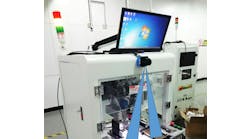What is a diagnostic tool? Similar to automated machines used in manufacturing, diagnostic tools can be fully automatic, semiautomatic or manual devices. Sensors, smart devices, instrumentation, handheld meters and equipment can all be considered diagnostic tools and are often used as such in industry. These tools provide assistance to get a machine running again quickly. They also can help to predict failure or adjustment issues.
Position and presence sensors on a machine, as well as servo drives and smart devices with built-in diagnostics, are diagnostic tools, just as digital multimeters, ultrasonic inspection instruments and vibration meters are.
Diagnostics should be systemic to a machine. Everything that can provide diagnostic information and guidance should, and it is important to spend the time to identify diagnostic opportunities and create the programming, if necessary or possible. In many cases, other manually operated instruments and devices may be needed.
Just as all sensors and devices can be diagnostic tools, all issues with sensor state, position, motion, vibration, temperature and electrical signal should be on the table for diagnosis.
In many cases the sensor is already present on the machine and with a little programming a diagnostic tool or function is born. Problems with presence, absence, not in position and jams must be diagnosed and presented to an operator via an HMI. Diagnostics start with the sensors installed for machine control.
The machine cylinders and actuators have end of travel sensors, and a part can be detected in a nest. Not only should these sensors be used to confirm that machine sequence steps are reached, but, if a position is not reached, the program should detect the error. Fault logic must be added to detect the error.
Other basic problems to diagnose include operator errors. For example, an operator may be trying to enter a set point that is too high or low. Instead of just limiting the variable range, the HMI should tell the operator what is wrong—for example, "The set point is out of range."
It would be easy if all diagnostic sensors just turn off a fail-safe discrete signal when a problem occurs, but there is much more to it than that. Many sensors and smart devices have significant diagnostic tools built in. Instruments can signal over or under range and broken wires. Others, such as IO-Link devices, provide a wealth of diagnostic information, as well. Every piece of data doesn't need to be monitored, but some should be used to help diagnose that a problem exists. This may include general health status bits and voltage, current or other analog signal levels.
A variety of motor drives also have built-in diagnostic tools. Much more detail than a single fault output is possible, especially with industrial Ethernet connections. Dozens of status and fault conditions can be monitored, detected and reported.
Sometimes adding a sensor is needed for improved monitoring and diagnostics. This is becoming more popular due to the ever-expanding world of the Industrial Internet of Things (IIoT). Temperature, pressure, flow and vibration sensors can be added and monitored by a controller. That data can also be saved to a file, a database or the cloud, and there are many ways to do it. However, some controllers and HMIs act as Web servers. It's built-in, and others use apps, so start there. Get the data to the controller or HMI.
Today an engineer, operations manager or maintenance technician may need to review the data for usable information to diagnose problems. Many diagnostic tools are or will soon be using analytics, machine learning and artificial intelligence to find problems. The tools available continue to expand.
Even before the analytics and predictive maintenance diagnostic tools are involved, simply plotting the data on a line chart with high and low limits or a trend chart can provide usable information for the operator. Look at the trend and break it down. Check with some HMI vendors, but it wouldn't take much programming to use the data to create an excellent diagnostic tool.
Beyond using sensors, smart devices and data as diagnostic tools, consider manual tools, as well. A handheld vibration or infrared (IR) temperature sensor to manually monitor motors and gearboxes and then understanding the data collected can be a first step to creating a real-time diagnostic tool. As the data complexity and detail increase, built-analysis on a tester is needed, possibly along with an experienced user. An ultrasonic tester is an example. Weld inspection for cracks and voids, sheet metal and wall thickness testing, and leak testing need more advanced diagnostic tools.
Some of these advanced diagnostic tools are well-developed with simple operating procedures and a robust design. The problem is a trained operator is often needed, along with well-defined requirements before the diagnostic tool is effective.
Diagnostic tools help to find problems that are adversely affecting production or quality, so keep a full toolbox of sensors, devices and equipment. Whether it’s a sensor, smart device or a manual handheld instrument, all should be used for effective troubleshooting devices.






